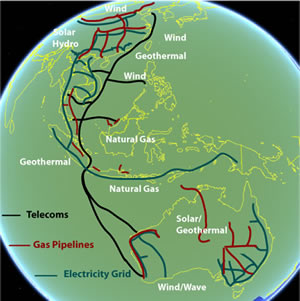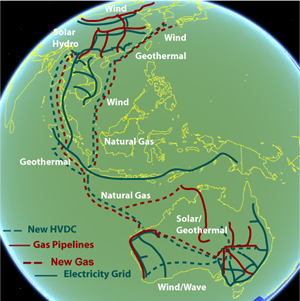 American Innovation, Chinese Transmission, Australian Clean Energy: The Ideal MatchMay 9, 2009 - Stewart Taggart - DESERTEC It's a combination that could dramatically reshape Asia for the better. As the US cedes global economic primacy, China struggles with crippling environmental pollution and Australia mulls a military buildup, ensuring Asia's future stability is a looming geopolitical issue. A farsighted solution would be to use the next 20 years of geopolitical transition to bind Asia into a universally-beneficial regional energy grid that will reduce the potential for conflict over resources, particularly energy. In "Australia 2050, Clean Energy Superpower," DESERTEC-Australia proposes a pan-hemispheric High-Voltage Direct Current power line and natural gas pipeline network stretching from the Great Australian Bight to Beijing. Through this network could flow everything from Southern Ocean wave energy to Mongolian wind power, 'load balanced' on a regional basis by cross-border natural gas and hydropower. In short, Asia could build the ultimate multilateral 'smart grid.' The benefits would be huge: more efficient transport of energy, greater security of energy supply, better price signals for investment, dramatic reductions in greenhouse gas emissions. The technology is there, the money is there, the brains are there, and the renewable energy is there.
America has an edge in business innovation and risk-tolerant venture capital. Australia has an edge in resources, particularly renewable energy. China has an edge in High Voltage Direct Current power lines, and soon Ultra High Voltage Power lines. And therein lies the solution: use American venture capital expertise to encourage renewable energy experimentation throughout Asia, including Australia, with the Chinese providing Ultra-High Voltage Direct Current power line technology. Natural gas pipelines could then be laid alongside. The Chinese wouldn't dare shut down the transmission system for political reasons (like the Russians might) because China is an importer of energy. Australia and Southeast Asia wouldn't dare withhold energy supplies, because that would lose them needed revenue. And with everyone drinking from the same well, attentive maintenance could be assured. Downstream backup supplies like fuel cells, electric vehicle fleets, hydrogen and distributed natural gas supplies could offset any short-term delivery disruptions. Demand management agreements with discretionary customers could provide a further buffer. With access to her future energy resources ensured, China would have less need to project maritime military power. If China built a smaller Navy, Australia would need to build a smaller countermeasure military -- allowing both to focus on 'butter' instead of 'guns.' A recent US study "A Roadmap for U.S.-China Cooperation on Energy and Climate Change" noted the United States and China had in common large renewable energy resources and aging, inefficient energy transmission infrastructures. The same can be said for Australia. The templates and roadmaps are there for cooperation. Fitting out Australia with a transcontinental High Voltage Direct Current transmission system and a unified national gas pipeline system would cost about US$23 billion, or roughly three percent of Australian GDP. That's less than Australian Prime Minister Kevin Rudd's proposed US$32 billion national broadband system. The cost of a pan-Asian HVDC/natural gas pipeline system would cost about US$300 billion, or about two percent of Asian regional GDP. That's in line with estimates made by UK economist Nicholas Stern that the world needs to make investments of roughly two percent of GDP in the future if the world is to have any hope of avoiding the worst ravages of climate change. Renewable energy 'load balanced' by natural gas and hydropower, delivered across borders and with investment price signals delivered through carbon pricing could spark a massively positive investment boom in retooling the Asian hemispheric economy. It's a visionary solution that deserves serious consideration. Additional Reading Carbon Taxes/Chinese Divestment
from US Australia/Asia Chinese Pollution and Its Costs
Kevin Rudd's Proposed "Asia-Pacific
Community" Benefits to Asia China
poised to go all out with clean tech, May 7,
2009, San Francisco Chronicle DESERTEC-Australia has developed roadmaps
for how Australia's individual states can contribute
to the retooling of Australia's and Asia's energy
economy: To learn more, visit DESERTEC-Australia's website. To see DESERTEC-Australia's vision on video, click on the links below.
DESERTEC-Australia
is a member of the global DESERTEC community. It
promotes development of solar energy resources from
desert regions. Editor's Note: This opinion was provided by DESERTEC-Australia, please click here to sign up to their mailing list. This article is under copyright; permission must be sought from DESERTEC-Australia in order to reproduce it.
|
Email this page to a friend
If you speak another language fluently and you liked this page, make
a contribution by translating
it! For additional translations check out FreeTranslation.com
(Voor vertaling van Engels tot Nederlands)
(For oversettelse fra Engelsk til Norsk)
(Для дополнительных
переводов проверяют
FreeTranslation.com )



